How to protect against wildfires, encouarge wildlife and display the owners collection of cacti and succulents all on a meager water supply and a moderate budget?
It was extremely overgrown with native Oaks, Manzanita, Chamise and Poison Oak everywhere, especially in the trees. There was a small lawn planted on the slope and a bog below, that was it! We started by removing all of the Poison Oak (Toxicodendron diversilobum syn Rhus diversiloba) and Chamise (Adenostoma fasciculatum) which is incredibly flammable. We thinned the Oaks (Quercus wizlizenii and Quercus kelloggii) and pruned the lower branches up to prevent a fire ladder, whereby a wildfire jumps from the ground into the tree canopy. We had to remove the mature Manzanita (Arctostaphylos manzanita), because a low elevation snow storm knocked them all over!
We created a small upper terrace near the residence and a larger middle terrace for the informal patio, seating area and bog. As there were many existing ground birds on this site (California Quail, Brown Thrasher, Wild Turkey, to name a few) we wanted to create areas for cover without adding fuel for a fire. We also wanted to create patio spaces that were wildlife friendly and absorbed winter rain and run-off. Natural stone pavers and wall rock from the site combined with 6″ of compacted crushed gravel worked well for the patios and walkways. Birds love rooting around in it for food, leaves never feel out of place, the plantings can intrude into it, it’s inexpensive and it makes a wonderful sound when walking on it.
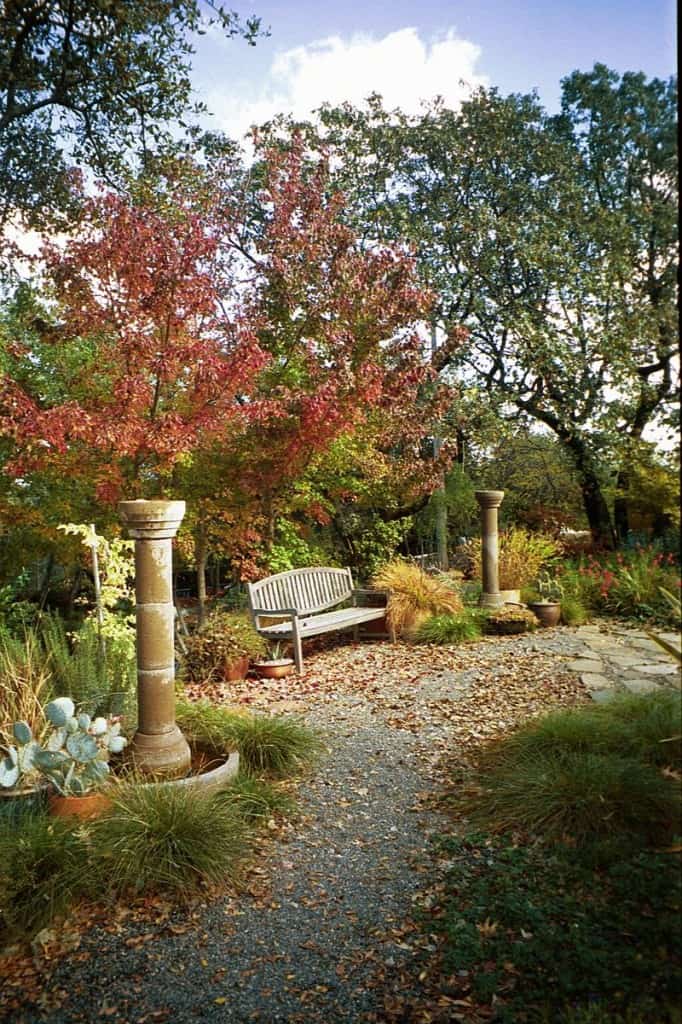
We added the Trident Maple (Acer buergeranum) grove, a fast growing small tree, to blend with the existing Black Oaks (Quercus kelloggii) and provide more fall color.
The rustic teak benches and columnar fountains were added to blend with other structures we built. These fountains are great for wildlife as birds love to bathe in the security of the upper bowls, hummingbirds and butterflies are attracted to water running down the sides. Berkeley Sedge (Carex divulsa syn. Carex tumulicola) was used around the edges of the expanded bog. This is a wonderful evergreen Sedge grass that tolerates boggy conditions to semi-drought conditions. It grows in full sun to part shade. Though it is not as colorful as Bronze Sedge (Carex comans ‘Bronze’) or Orange Sedge (Carex testacea), in my experience it is more reliable.

The owners had an extensive collection of cacti, succulents and exotics that needed a permanent home.
We did the research and decided to build a glass greenhouse. It is 25′ X 25′ with a 12′ ceiling beam. We installed a gas line for the heaters, electrical for the lights, automatic vents and fans and water for irrigation. Since the greenhouse was primarily for desert plants a misting system was not needed but a seasonal shade cloth was supplied for the hottest time of the year. The greenhouse sits on a Splitface cinder block foundation wall and has a redwood and hardware cloth bench system around the perimeter for the thousands of plants inside. We used crushed gravel under the benches and slate for the walkways with a large in-ground planting area in the center for the very large specimen cacti and Coral Tree. Researching and building this greenhouse was a treat.
The Mexican Blue Palm (Brahea armata) is the centerpiece to this planting. It is a slow growing cold hardy palm native to the desert of Northern Baja California. It needs good drainage and is planted up on a mound and will be quite stunning when mature. In addition cacti, Euphorbias, succulents and very tough perennials were used. There is no irrigation in this bed.

In this view of the greenhouse the summer shade cloth is visible as is the potting bench with a sink against the greenhouse.
The informality of the gravel walkway blends well with the native Oaks and the other plantings. Agaves, Aloes, cacti, succulents, Salvias, grasses and low water use perennials were used. No irrigation system was installed. The generous use of bark mulch, 4″- 6″ thick, keeps weeds under control, improves the soil and keeps the soil moist for as long as possible. This is an area of fairly high rainfall, over 30″ annually, and has a clay soil that holds moisture for a long period. Making sure that plants don’t rot in the winter from too much moisture requires good planting and grading techniques.

Silver Germander (Teucrium cossonii majoricum) is the beautiful lavender flowered prostrate groundcover along the walkway.
Teucrium blooms for months in the dry season with no irrigation. Trichocereus and Opuntia cacti, Agave, Euphorbia and Mexican Feather Grass (Nassella tenuissima syn. Stipa tenuissima) are all in this photograph. Mexican Feather Grass is a wonderful billowy grass that changes color season to season but should not be used in a highly irrigated landscape as it will quickly become a pest, sprouting everywhere and may have potential to be an escaped exotic. In the background the heart-shaped foliage of Western Redbud (Cercis occidentalis) native to the site is visible. This is a beautiful native shrub/small tree that should be used more often in the landscape.
large “lawn” pads of exposed aggregate concrete were used to blend with the crushed gravel. Instead of grass surrounding them we used a variety of tough plants in this partially shaded area; Strawberry Geranium (Saxifraga stolonifera), Hardy Begonia (Begonia grandis), Dwarf Heavenly Bamboo (Nandina domestica ‘Compacta Nana’), Peruvian Lily (Alstroemeria spp.), Red Hot Poker (Kniphofia uvaraia), Creeping Lilyturf (Liriope spicata) and Stonecrop (Sedum album) between the stepping stones. Sedum album can be invasive, but when it gets no irrigation it is much easier to control and take advantage of its toughness. The “entrance” structure columns are from the same manufacturer as the fountains and was designed to have a heavy, rustic feel to it. Notice the low-voltage lights on the structure to light the walkways at night. There is extensive lighting throughout this project, we love lighting!
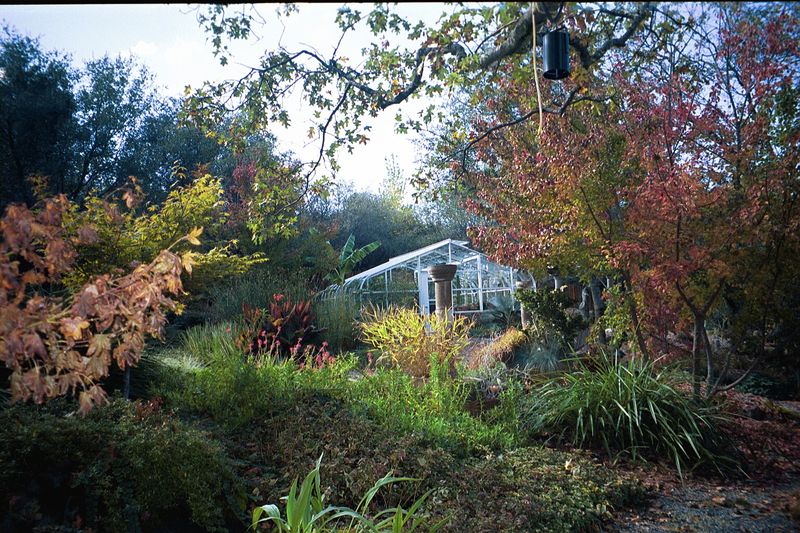
Speaking of lighting, there is a can light suspended from the branch of the Black Oak in the foreground.
There are more lights higher up in the tree that create a “moonlight” effect through the tree branches. The rope hanging here is from a bird feeder that broke recently, oops! But one way to encourage birds is with feeders and then to back off as plant material grows in. There were numerous Woodpeckers, Flickers, Nuthatches, Creepers, Towhees and other birds on this site and they all came back and made new homes. The owners also mounted nesting structures throughout the property. In the foreground are some other tough plants; Creeping Raspberry (Rubus calcyinoides ‘Emerald Carpet’), Chinese Ground Orchid (Bletilla striata), Spring Snowflake (leucojum vernum) and Houttuynia (Houttuynia cordata ‘Varieagta’) which receive little or no irrigation. Houttuynia can be invasive and thrives in wet soil, so to control it, either contain it or don’t irrigate it.
We planted water loving species in this area and they flourished. In the bog we planted Canna Lily (Canna ‘Tropicana’), Japanese Iris (Iris ensata ‘Variegata’) and Zebra Rush (Scirpus zebrinus) and others and they very quickly created areas that attracted a variety of birds, Dragonflies, Butterflies, toads, frogs, skinks, small garden snakes, raccoons, opossums and of course, squirrels. The bog needs yearly maintenance to remove dead foliage, but the show of wildlife is worth the effort.
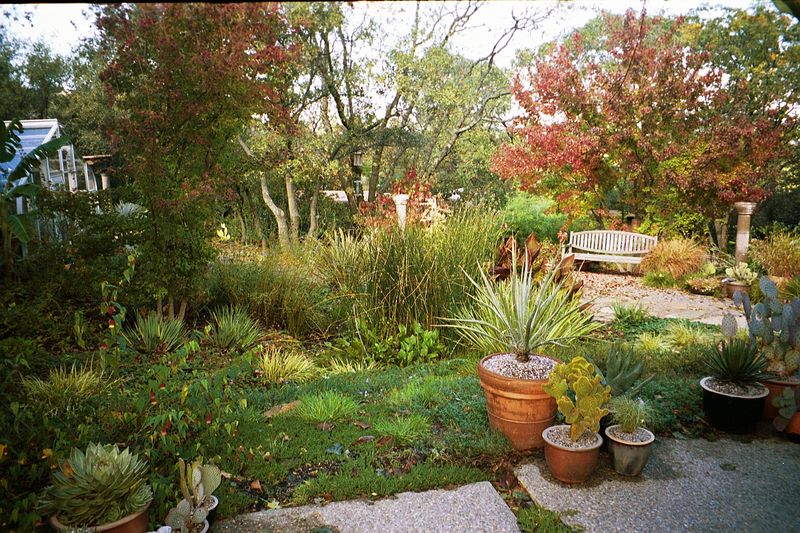
Though the hardscape is fairly structured in this design, we wanted to create informality in the plantings, to blur the edges.
The owners desired this, the existing trees and topography suggested it and their collection of container plants almost required it. Being sensitive to the existing plant life and wildlife was an interesting challenge.
Some cacti were kept outside the greenhouse year-round in containers and some were moved inside when it was very wet. We did not want to create a desert garden as this would not have blended with the Oak trees, so we used them as accents and the worked well for this. They require very little irrigation and little maintenance, and no one bothered them!
We developed this slope with boulders from the site and extensive shade plantings. This area was irrigated and contributed to the bog during the summer months. This garden is a garden of textural contrasts and even out of bloom has lots of visual interest.




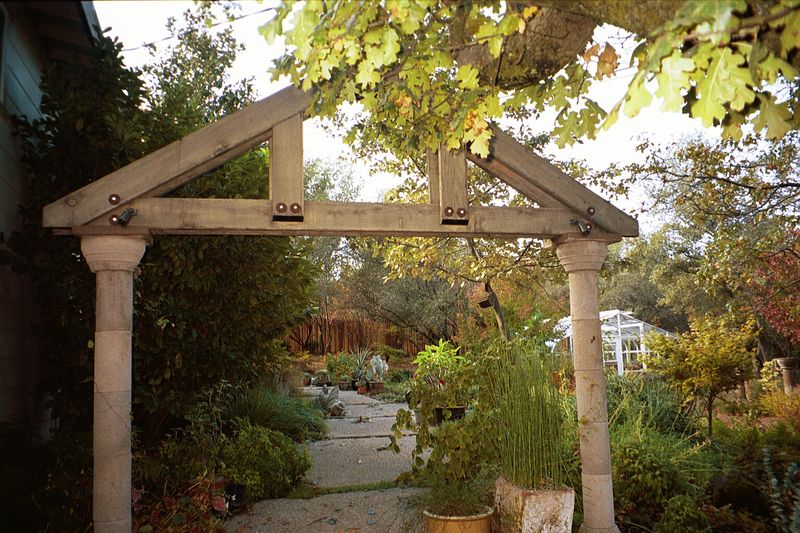
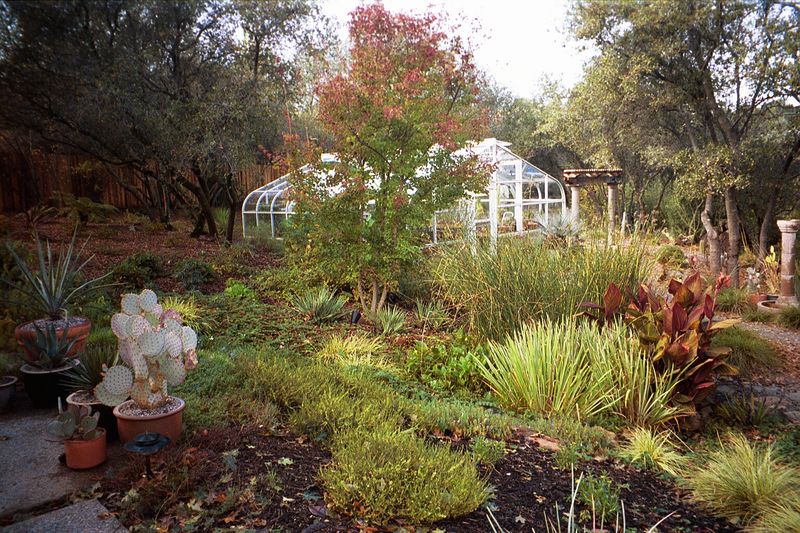
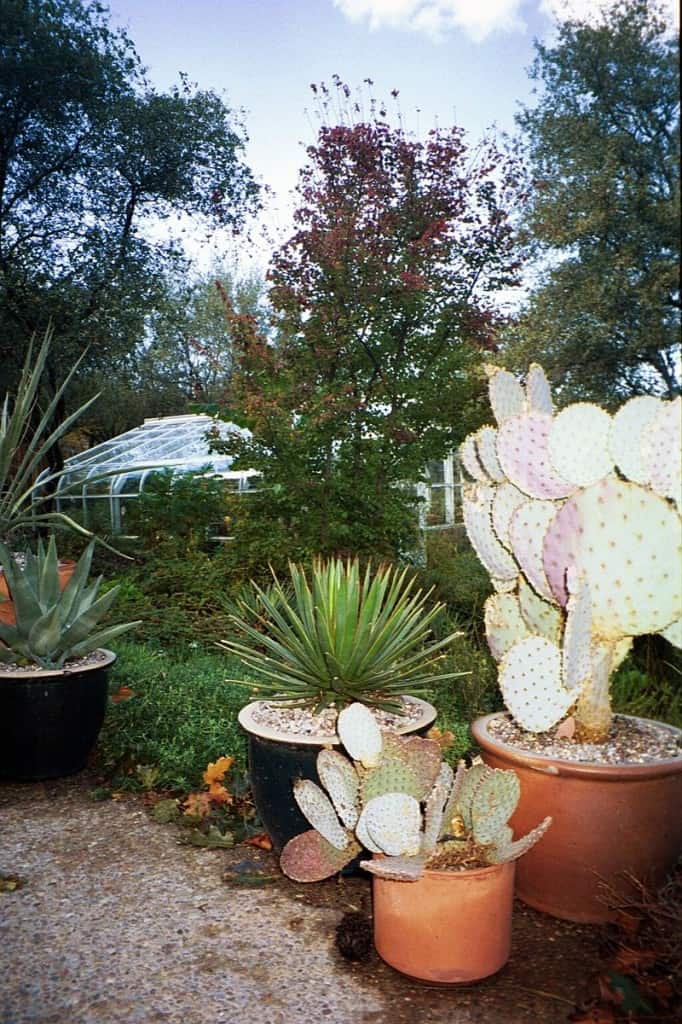
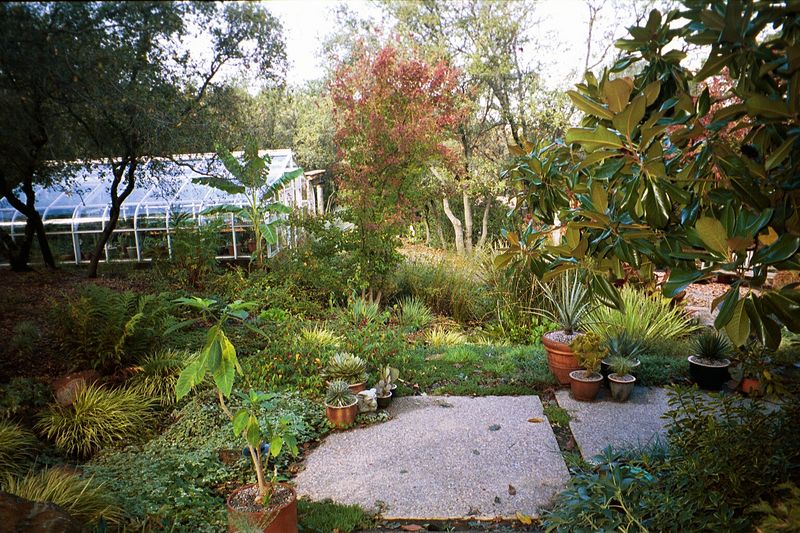

Follow Us!